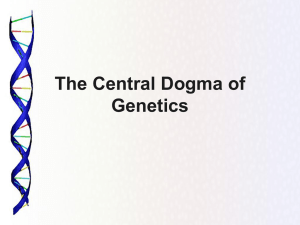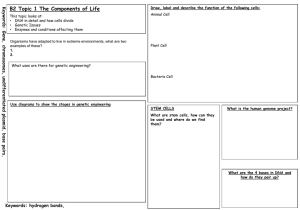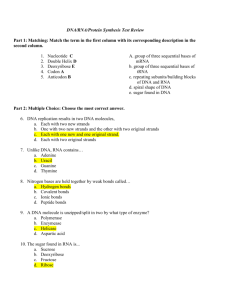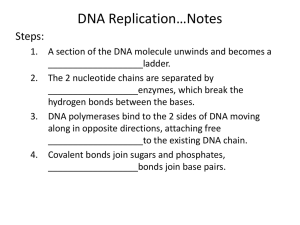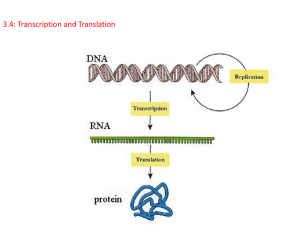Biology 2.7 Assess Sched 15
advertisement
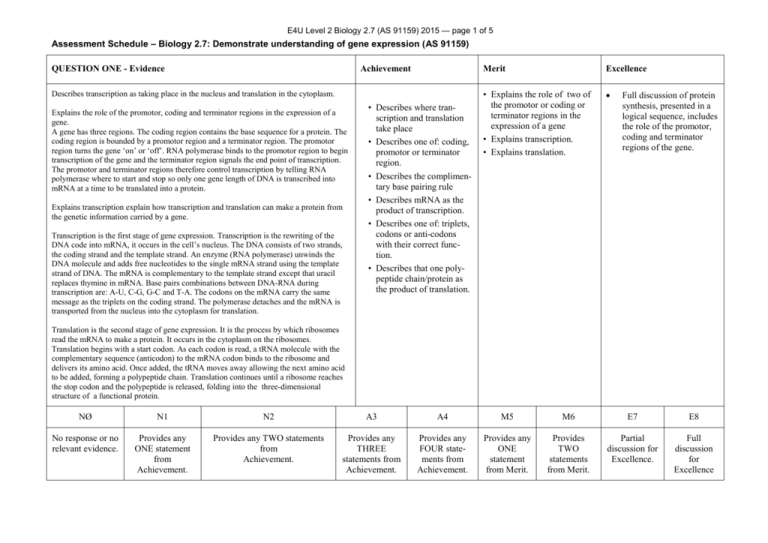
E4U Level 2 Biology 2.7 (AS 91159) 2015 — page 1 of 5 Assessment Schedule – Biology 2.7: Demonstrate understanding of gene expression (AS 91159) QUESTION ONE - Evidence Achievement Describes transcription as taking place in the nucleus and translation in the cytoplasm. Explains the role of the promotor, coding and terminator regions in the expression of a gene. A gene has three regions. The coding region contains the base sequence for a protein. The coding region is bounded by a promotor region and a terminator region. The promotor region turns the gene ‘on’ or ‘off’. RNA polymerase binds to the promotor region to begin transcription of the gene and the terminator region signals the end point of transcription. The promotor and terminator regions therefore control transcription by telling RNA polymerase where to start and stop so only one gene length of DNA is transcribed into mRNA at a time to be translated into a protein. Explains transcription explain how transcription and translation can make a protein from the genetic information carried by a gene. Transcription is the first stage of gene expression. Transcription is the rewriting of the DNA code into mRNA, it occurs in the cell’s nucleus. The DNA consists of two strands, the coding strand and the template strand. An enzyme (RNA polymerase) unwinds the DNA molecule and adds free nucleotides to the single mRNA strand using the template strand of DNA. The mRNA is complementary to the template strand except that uracil replaces thymine in mRNA. Base pairs combinations between DNA-RNA during transcription are: A-U, C-G, G-C and T-A. The codons on the mRNA carry the same message as the triplets on the coding strand. The polymerase detaches and the mRNA is transported from the nucleus into the cytoplasm for translation. • Describes where transcription and translation take place • Describes one of: coding, promotor or terminator region. • Describes the complimentary base pairing rule • Describes mRNA as the product of transcription. • Describes one of: triplets, codons or anti-codons with their correct function. • Describes that one polypeptide chain/protein as the product of translation. Merit Excellence • Explains the role of two of the promotor or coding or terminator regions in the expression of a gene • Explains transcription. • Explains translation. Full discussion of protein synthesis, presented in a logical sequence, includes the role of the promotor, coding and terminator regions of the gene. Translation is the second stage of gene expression. It is the process by which ribosomes read the mRNA to make a protein. It occurs in the cytoplasm on the ribosomes. Translation begins with a start codon. As each codon is read, a tRNA molecule with the complementary sequence (anticodon) to the mRNA codon binds to the ribosome and delivers its amino acid. Once added, the tRNA moves away allowing the next amino acid to be added, forming a polypeptide chain. Translation continues until a ribosome reaches the stop codon and the polypeptide is released, folding into the three-dimensional structure of a functional protein. NØ N1 N2 A3 A4 M5 M6 E7 E8 No response or no relevant evidence. Provides any ONE statement from Achievement. Provides any TWO statements from Achievement. Provides any THREE statements from Achievement. Provides any FOUR statements from Achievement. Provides any ONE statement from Merit. Provides TWO statements from Merit. Partial discussion for Excellence. Full discussion for Excellence E4U Level 2 Biology 2.7 (AS 91159) 2015 — page 2 of 5 Q TWO (a) Expected Coverage Coding DNA Template DNA mRNA Amino acid Achievement ATC ATC TTT GGT TAG TAG AAA CCA AUC AUC UUU GGU IIe IIe Phe Gly Coding DNA Template DNA mRNA Amino Acid ATC ATT GGT TAG TAA CCA AUC AUU GGU IIe IIe Gly (c) Explains how the deletion mutation affects the sequence of the bases in the DNA and the final protein. The deletion of three DNA nucleotides, CTT, results in a (reading) frameshift. A frameshift typically alters all the triplets on the DNA that follow and when transcribed into mRNA the codons produce a different sequence of amino acids are translated. This may results in early termination of protein synthesis when a STOP codon is transcribed on the mRNA. Therefore no protein is made, or a protein is made that has no biological function. This occurs in the deletion mutation that causes cystic fibrosis, the amino acid, Phe, is deleted Excellence • In (a) correctly completes the normal template DNA sequence in the table. • In (a) correctly completes the normal amino acid sequence. • In (b) correctly completes one row or column of the table. (b) Merit • In (c) describes that the deletion mutation causes a reading frame shift. • In (c) describes a change to the protein: e.g. a polypeptide will be shortened by a premature STOP codon. • In (c) describes that each amino acid can have more than one codon code or AUU and AUC both code for IIe. • In (b) correctly completes the table. • In (c) explains how the frame shift causes a shift in the ‘reading frame’ of the triplet code. • In (c) explains why the second amino acid stayed the same. • In (c) fully discusses links between mutation in the DNA (triplet) to corresponding codon, and amino acid in the context of cystic fibrosis. E4U Level 2 Biology 2.7 (AS 91159) 2015 — page 3 of 5 from the sequence and the protein cannot perform its transport function. Explain why the second amino acid stayed the same and link this to the degeneracy of the genetic code. There are 64 different codons that code for 20 amino acid , so several codons code for the same amino acids. In normal DNA the second codon AUC codes for the amino acid, IIe. By chance, the deletion of CCT changed the second codon by only a single letter to AUU. This variation in the third letter of the codon did not change the amino acid. Coding DNA Template DNA mRNA ATC ATC TTT GGT TAG TAG AAA CCA AUC AUC UUU GGU NØ N1 N2 A3 A4 M5 M6 E7 E8 No response or no relevant evidence. Provides any ONE statement from Achievement. Provides any TWO statements from Achievement. Provides any THREE statements from Achievement. Provides any FOUR statements from Achievement. Provides any ONE statement from Merit. Provides TWO statements from Merit. Discusses deletion mutation. Fully discuses the CFTR mutation. E4U Level 2 Biology 2.7 (AS 91159) 2015 — page 4 of 5 QUESTION THREE - Expected Coverage Achievement Discuss how the metabolic pathway for choline and the internal gut environment interact to influence fish odour syndrome. • Describes the term metabolic pathway, eg a series of enzyme controlled reactions. A metabolic pathway is a sequence of enzyme controlled reactions. The product of one enzyme controlled reaction becomes the substrate for the next enzyme controlled reaction in the metabolic pathway. An interruption in the reaction series prevents the pathway from progressing to the end and can result in a metabolic disorder. When this happens, there might be too much of one substance or too little of another and the phenotype is affected. • Describes that the product(s) of one reaction are the reactants (substrates) for subsequent reaction(s). In the gut foods rich in choline such as meat and eggs provide the substrate for enzymes made by the gut bacteria to produce trimethylamine (TMA) and this compound has a strong fishy smell. People with a normal FMO3 gene can make the FMO3 enzyme so that the intermediate substrate, TMA, is broken down to odourless trimethylamine N-oxide (TMAO), the end-product of this metabolic pathway. If the FMO3 enzyme is missing or its activity is reduced because of a mutation in the FMO3 gene, TMA builds up in the body to be excreted in sweat that gives off a strong fishy odour. Typically people with fishy odour syndrome avoid meat and eggs to reduce the amount of choline substrate in their gut environment. Without this substrate the smelly intermediate substrate TMA can not be made. This is the recommended treatment because the genotype of a person with fishy odour syndrome cannot be changed but the internal gut environment and therefore the amount of choline substrate is able to be modified by a change in diet. • Describes that the genes contained in gut bacteria codes for enzymes that catalyses the reaction of choline to trimethylamine. Merit Excellence • Explains genes and enzymes control a metabolic pathway. Discusses how the metabolic pathway for choline and the internal gut environment interact to influence fish odour syndrome. • Explains how the metabolic pathway may be affected when any the FMO3 enzyme is non-functional. • Explains why a diet low in meat and eggs is the recommended treatment • Describes that FMO3gene codes for the FMO3 enzyme that catalyses the reaction of trimethylamine to trimethylamine N-oxide. NØ N1 N2 A3 A4 M5 M6 E7 E8 No response or no relevant evidence. Provides any ONE statement from Achievement. Provides any TWO statement from Achievement. Provides any TWO statements from Achievement. Provides any THREE statements from Achievement. Provides ONE statement from Merit. Provides TWO statements from Merit. Partial discussion Full discussion linked to diet. E4U Level 2 Biology 2.7 (AS 91159) 2015 — page 5 of 5 Judgement Statement Score range Not Achieved Achievement Achievement with Merit Achievement with Excellence 0–6 7 – 12 13 – 18 19 – 24

